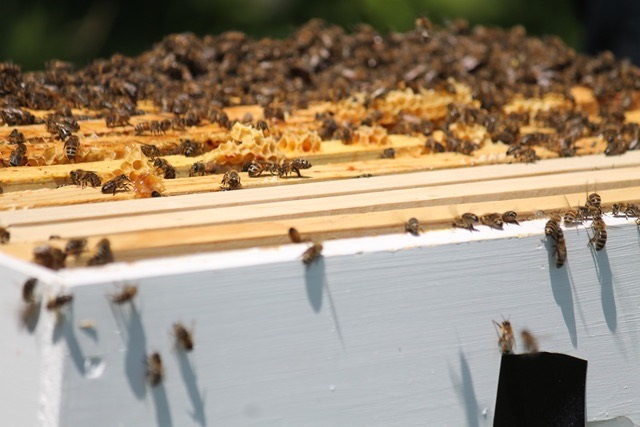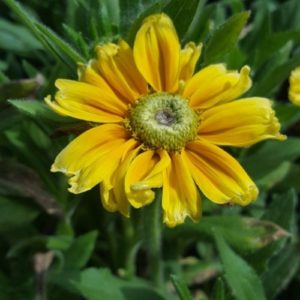By Russell M. Gullo
With bee populations declining at a catastrophic rate, many gardeners are asking what they can do to help. They realize that a robust bee population is critical to a healthy ecosystem and food supply. In fact, 1/3 of the food that we eat every day relies on pollination primarily from bees. About 80% of crops in the US are dependent on bees for pollination, as well as many crops fed to livestock. Without them, there would be no us. The good news is that there are many things we can do to help right in our own gardens.
Why pollination is important
Pollination occurs when a pollinator (such as a bee) transfers pollen from one flower of the same species to another. This results in fertilization and subsequent production of fruit, vegetable, nut, or seed. Without this vital process fully taking place, crop yields are generally very poor. Although some plants pollinate themselves, or through other methods (wheat is pollinated by the wind), most are dependent on this process, with bees being the most vital pollinators.
What you can do
There are so many things you can do, some very simple and some more involved. If every gardener took a few small steps, the impact would be tremendous. Consider trying one or more of these ideas.
Build a bee habitat
I spoke with Joe Cutolo of EggHead Farm in Orchard Park, N.Y., and he told me everything you need to know about starting your own bee habitat. Cutolo runs a small family farm and has incorporated bee habitats to aid in pollination and increase his crop output. It all started for him and his wife as a lesson for their children. “I have small children (4 and 6), and we wanted to teach them where their food comes from, and grow food without chemicals or sprays. At our house, we started with a small vegetable garden, and rows of strawberries. We loved being able to send the kids outside to pick tomatoes and strawberries, and eat them right from the vines. After that, we got some chickens and planted apple trees. As I have found, this is a pretty common path, and there are lots of people who have done the same. The next step is to get some bees, to keep everything pollinated. Going out to ‘check on the bees’ has been a great activity with the kids. It has encouraged them to learn what all the different plants are in our yard, and which other bugs are ‘good ones’. And I always have volunteers to help me sample newly harvested honey.”

Cutolo working on his hive
According to Cutolo, “You don’t need a huge yard to start. It’s best if you have a corner of your property that can face south/southeast, so that the bees get some morning sun to wake them up. Bees won’t really bother anyone that doesn’t go near the entrance to the hive, but when they find a food source, they go directly at it once leaving the hive… hence the term ‘bee line’. You want to be a good neighbor, and make sure that you don’t turn a neighbor’s yard into a bee superhighway. You also want to make sure that you put the hives out of the way of where people congregate or kids play. Bees won’t bother anyone if you give them a little space or avoid blocking their path home.”
” If you want to get into beekeeping, be prepared to be obsessed with your bees. The first year, I read tons of books and articles. I joined beekeeping groups online, and I became an apprentice at a local apiary (bee yard).”
“There are a few different ways to get the bees; you can buy a small colony that is already established (called a Nuc), you can buy a ‘package’ where you provide the boxes, and the bees build into it, or you can try to catch a swarm of bees, which is not as horrifying as it may sound. The first is the easiest. Nucleus Colonies come with frames of wax that the bees have already established. It’s their home. It’s the beekeeper’s job to give them room to grow. The other two ways, you are getting bees, and giving them a place to live, but they are starting from scratch. It’s harder work for them, and for the beekeeper, because all their effort is put into the hive, and there will likely be no extra honey for them to share. Catching a swarm is not really something for beginners, but after a season or two, it’s definitely something you’ll have the confidence to try. Sometimes the bees decide to leave (that’s called a swarm) and it can be heartbreaking. You can spend a lot of time and effort on your bees, and when you go to your hive, to find they have left, or that an animal has raided the hive, it definitely stings. No more puns, I promise… The key is to not get discouraged. Bees are disappearing. Even experienced beekeepers lose bees. The important thing is to keep at it. If you want to get into beekeeping, be prepared to be obsessed with your bees. The first year, I read tons of books and articles. I joined beekeeping groups online, and I became an apprentice at a local apiary (bee yard). The most important thing I learned is that there’s no single right way to be a beekeeper. Bee hives truly have different personalities, and you will get to know that certain things are right for one hive, and not for another. Some hives will let you open them up, and work inside, and they don’t seem to notice. Others will get riled up as soon as you open the lid. It all depends. The best way to get started is to join a group and/or take a class. Talk to people who have bees and see if you can come over when they work on them. You will have to buy some basic equipment, protective hat to cover your face, gloves, hive tools, and the hive bodies themselves. One of the questions that people always ask is, ‘Am I going to get stung?’ The answer is… probably. In the same way that if you work with dogs or cats long enough, you’ll probably get bit or scratched. If you’re allergic to bee stings, or don’t think you can tolerate being stung, you can still help the bees. Bees can travel a 2 mile radius from their hive to look for food, so what you do in your own yard can help a local colony.”

EggHead Farm’s pollination staff
I asked Cutolo how one can tell the difference between the various types of bees. “It’s important to know what kind of bee you’re looking at. Many people don’t know the difference between a honey bee and a yellow jacket (which looks a lot like a honey bee). Honey bees can only sting once, and then they lose their stinger and die; so it’s in their best interest to leave you alone. Yellow jackets and hornets are a kinds of wasps that can and will sting multiple times. They make nests in the ground, or on houses, and the nests look like grey footballs. They’re not pollinators. Don’t let their yellow stripes ruin the good name of the honey bee. You may have the perfect property for bees, but you’re not ready to get your own hives. You can let someone else put a hive on your property. Contact a local bee keeping group (easy to find on social media) and a local beekeeper may be looking for a place to put more hives.”
For even more information, check out Cutolo’s podcast “Shouldn’t Even Be Here”. They will be interviewing a local bee expert on the podcast next month. The show is not usually bee related, but Cutolo states “we like to talk to interesting people who do interesting things.” Email ([email protected]) or tweet (@notevenbehere) them any questions you have, and they will try to get them answered. Subscribe on your favorite podcast app and get notified when new episodes come out. The full list of platforms can be found at: https://anchor.fm/shouldntevenbehere
Plant a diverse garden
Bees need a steady supply of food from spring to fall. Plant a wide range of plants that flower at different times of the year to help them out. Bees like to focus on one plant at a time, so it is helpful to plant in bunches. Avoid double-blooming flowers, as they have little nectar and pollen. Bees have their favorite plants as well.
Bee Favorites:
Avoid pesticides
There are many factors contributing to the alarming decline in bees. Verroa mites destroy colonies and are currently a major issue facing bee population. Nutritional deficiencies from loss of habitat is another. The use of certain pesticides, specifically ones containing neonicotinoids, is a third. Neonicotinoids are particularly devastating to bees and other insects because the plant takes in the chemical systemically. When a bee or insect feeds on the plant, it receives a lethal dose and dies. Consider using a natural solution, such as Espoma Neem Oil 3n1. If you absolutely have to spray a plant to prevent its death using a neonicotinoid, spray it when it is not in bloom. I asked Cutolo his thoughts on this and he added “Bees may not be directly killed by ‘bee safe’ pesticides, but more and more research is coming out that these broad spectrum pesticides and herbicides are effecting the long term health of all pollinating insects. Leaving clover in your yard is a huge help. Bees love clover, and it makes great honey. Even though we all like to see a perfect yard of green grass, a yard full of tiny flowers is amazing for the bees.”
Blue, purple, yellow
Bees are most attracted to these three colors. Although their visual acuity is much worse than humans, they can hone in on these three colors the most effectively. Scientists have found that plants actually evolved over millions of years to the vibrant colors we know today to attract pollinators. Bee Balm (as the name implies) is one of their favorites, flowering purple in summer.
Provide Water
Bees need to drink too. Help them out by providing a shallow pool of water for them to land and have a drink. A birdbath with some small stones in it to serve as a landing pad is ideal.
Plant a flowering tree
Perhaps not as obvious as flowers and crop plants, flowering trees actually provide the majority of nectar to bees. A mature flowering tree such as a Cleveland Select Pear can have thousands of blooms for bees to feast on in spring. Trees also provide materials to build nests, and even can serve as a home for some types of bees in its cavities.

















